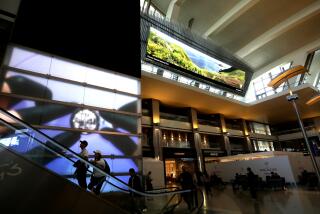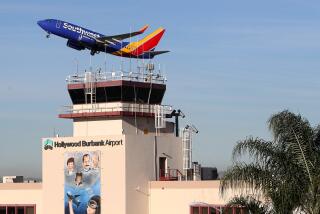Neighbors Sound-Test Airport Noise Plan : Environment: A Van Nuys committee invites residents for a computerized demonstration. Their reaction is not favorable.
Neighbors of the Van Nuys Airport had a rare opportunity Monday night to listen to the effects of a proposed noise-reduction plan--and they weren’t impressed.
An environmental planner armed with a high-tech, noise-generating computer demonstrated at an airport committee meeting the sounds of various aircraft from different sites around the airport. He also demonstrated how much quieter the noise would be if the airport adopts a proposed noise-reduction plan.
The noise demonstration by David Dubbink, a private environmental planner hired by the city of Los Angeles, was requested by members of the Van Nuys Airport Part 150 Committee to demonstrate to airport neighbors the impact of a noise-reduction plan. Homeowners have complained that the proposal does not go far enough in eliminating noise.
Through two-foot high speakers receiving sound inputs from a compact disc player controlled by a portable computer, Dubbink showed how the proposed plan would reduce noise by playing the sound of the Lear 25 jet taking off. He then contrasted it to the sound of the same aircraft taking off under the reduced-thrust requirements.
The sound of the jet taking off was measured at 101 decibels, which forced several people in the audience to cringe and cover their ears. The sound of the jet taking off under the reduced thrust requirements was 10 decibels quieter.
“What’s the difference?” a woman in the audience asked as the sound of the jet faded away.
Because sound increases on a logarithmic scale, Dubbink later pointed out, a reduction from 101 to 90 decibels is actually a drop of about half in intensity.
“Probably nobody has heard airplane noise in a room as loud as we have,” said Maurice Laham, an environmental manager for the city’s Department of Airports.
After the noise-reduction demonstration, several neighbors in the audience complained that airport officials have not done enough to reduce airport noise.
The committee, which includes residents, pilots and airport officials, has tentatively backed a plan that would require pilots to voluntarily reduce airplane thrust during takeoffs and would expand by one hour a nighttime ban on departures by planes generating 74 or more decibels of noise on takeoff. The present noise curfew extends from 11 p.m. to 7 a.m. The proposal would begin the curfew at 10 p.m.
According to airport sound-monitoring equipment, aircraft noise that often exceeds 65 decibels now reaches 3,263 people living in 1,445 houses near the airport. Under the proposed scenario, that amount of noise would only reach 847 people living in 378 houses, according to the airport study.
Dubbink said that by comparison, normal conversation heard three feet away measures 65 decibels, and a typical jackhammer measures 88 decibels when heard from 50 feet away.
A homeowners’ proposal to impose a noise limit throughout the day and prohibit all non-emergency jet takeoffs at night would shrink that number within five years to 12 people in four single-family houses, according to a study by the Department of Airports. The daytime noise limit would ban those jets classed by the Federal Aviation Administration as generating 74 decibels of noise on takeoff.
But airport officials and a city attorney have criticized the proposal, saying it would leave the airport open to lawsuits by airport tenants whose businesses would suffer.
The committee is scheduled to meet March 24 to make a final decision on which noise-reduction plan to adopt.
The noise-reduction proposals are in addition to a noise ordinance proposed by the Los Angeles Board of Airport Commissioners that would phase out the noisiest jets using the airport over a six-year period. Final adoption of the ordinance is expected in the spring.
When adopted, the proposal would bar planes rated by the FAA as producing 85 decibels of noise on takeoff--which airport officials said would affect only a handful of older planes, mostly private jets, based at Van Nuys.
Between then and January, 1998, the maximum would gradually be lowered to 77 decibels.
More to Read
Sign up for Essential California
The most important California stories and recommendations in your inbox every morning.
You may occasionally receive promotional content from the Los Angeles Times.











